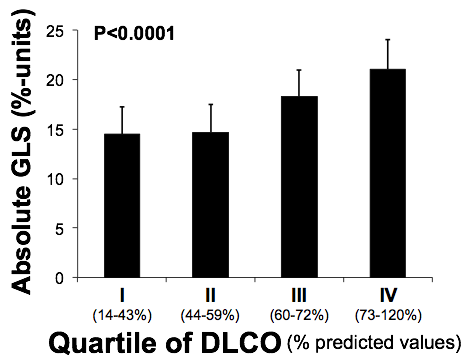Session Information
Session Type: Abstract Submissions (ACR)
Background/Purpose: Reduced diffusing capacity of carbon monoxide (DLCO) is a predictor of worse outcomes in patients with systemic sclerosis (SSc). Traditionally, the association between low DLCO and mortality in SSc has been attributed to either interstitial lung disease (ILD) or pulmonary vascular disease due to pulmonary arterial hypertension (PAH). However, patients with primary cardiac involvement in SSc may have reduced DLCO due to pulmonary venous hypertension and/or generalized vascular disease in SSc. We sought to determine the association between DLCO and cardiac mechanics (speckle-tracking strain parameters) in patients with SSc.
Methods: We studied 195 patients with SSc who were enrolled in the Northwestern Scleroderma Program. All patients underwent comprehensive echocardiography using a standardized protocol for image acquisition and interpretation. Indices of cardiac mechanics (LV, RV, and left atrial [LA] strain parameters) were measured using speckle-tracking analysis. We used multivariable-adjusted linear regression analyses to determine the association between DLCO and indices of cardiac mechanics.
Results: The mean±SD age was 51±13 years, 84% were female, 59% had limited cutaneous SSc, 31% had diffuse cutaneous SSc, and 10% had other forms of SSc (e.g., overlap syndromes). Prevalence of SSc complications were as follows: PAH in 10%, significant ILD in 18.5%, and LV systolic dysfunction (EF<50%) in 3.6%. DLCO was not associated with global LVEF, but it was associated with LV, RV, and LA strain parameters, and early LV diastolic (e') tissue velocities, on univariate analysis (P²0.001) (Figure). Reduced DLCO remained associated with reduced absolute global longitudinal systolic strain (GLS, a marker of longitudinal LV systolic function) after adjusting for age, sex, SSc subtype, SSc disease duration, PAH, ILD, e’ velocity (a marker of LV diastolic dysfunction), and tricuspid annular plane systolic excursion (a marker of RV function): µ-coefficient = -0.9 (95% CI -1.5 to -0.2) %-units, P=0.009. The association between DLCO and GLS persisted in the subset of patients with normal LVEF (>50%), no PAH, and FVC > 60% of predicted (multivariable-adjusted P=0.014).
Conclusion: In patients with SSc, reduced DLCO is associated with subclinical abnormalities in LV mechanics even in patients without evidence of ILD, PAH, or global LV systolic dysfunction. DLCO may be a marker of SSc cardiac disease.
Figure. Diffusing Capacity of Carbon Monoxide (DLCO) Quartiles vs. Absolute Global Longitudinal Strain (GLS). Lower DLCO is associated with worse left ventricular longitudinal systolic function as indicated by lower values of GLS.
Disclosure:
M. Hinchcliff,
Gilead Science,
9;
V. Daruwalla,
None;
L. Beussink-Nelson,
None;
S. Podlusky,
None;
M. A. Carns,
None;
J. Varga,
None;
M. Cuttica,
None;
S. J. Shah,
None.
« Back to 2014 ACR/ARHP Annual Meeting
ACR Meeting Abstracts - https://acrabstracts.org/abstract/reduced-diffusing-capacity-of-carbon-monoxide-is-independently-associated-with-worse-subclinical-left-ventricular-function-on-speckle-tracking-echocardiography-in-systemic-sclerosis/

